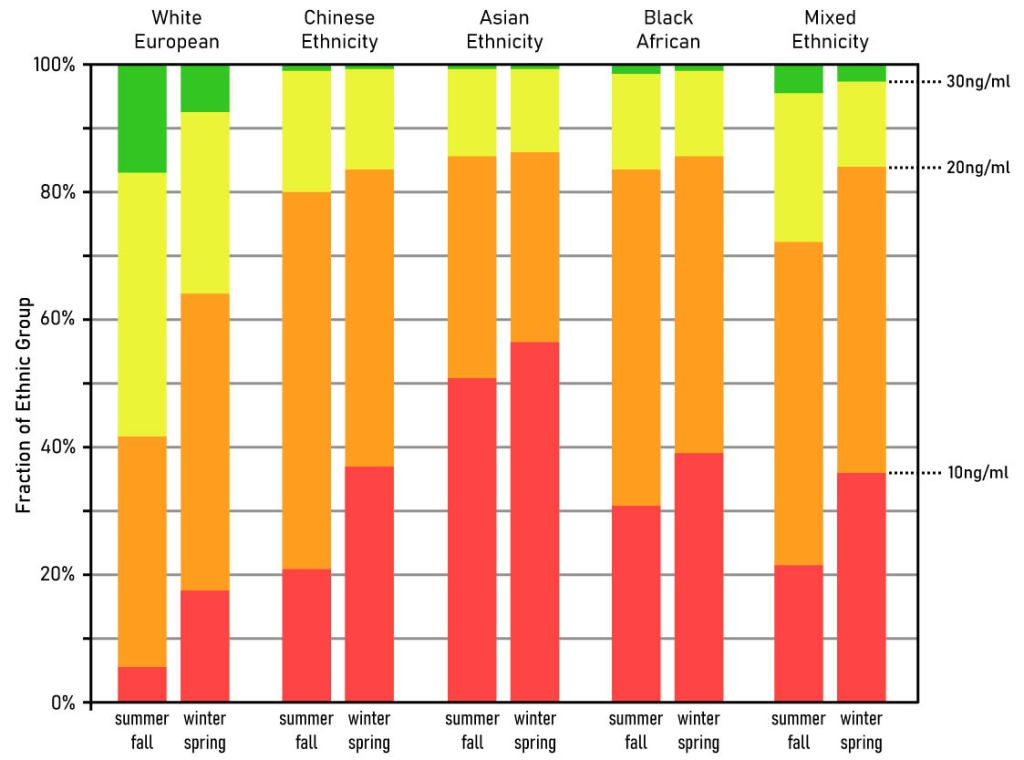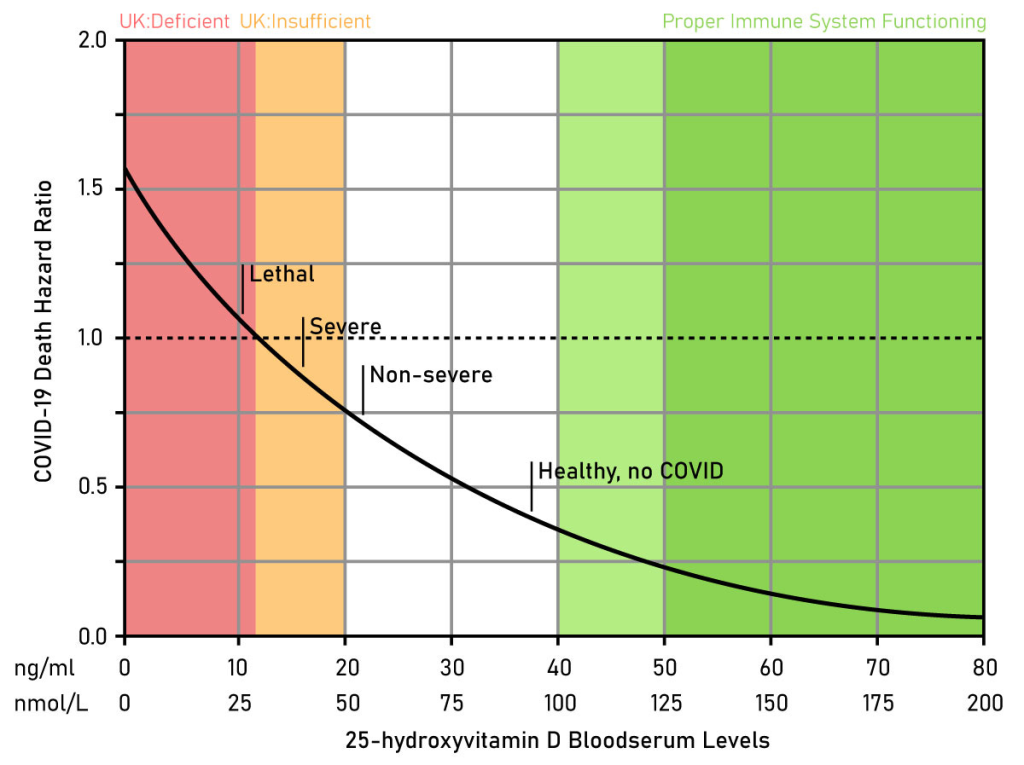As the media continues to push for large-scale vaccinations against seasonal respiratory diseases and take counterintuitive measures, the real pandemics affecting Western society are being ignored or even perpetuated. These two pandemics are the vitamin D deficiency pandemic and the correlated obesity pandemic.
Edited translation of an English-language article from the American language Sunfluencer.com
Vitamin D deficiency pandemic
There is no flu season, only a season low in vitamin D. About 80% of Americans are vitamin D deficient. The skin must be touched by sunlight to produce vitamin D, an immunoregulatory hormone. Dark skin contains melanin, an effective natural sunscreen that reduces vitamin D synthesis. The correlation of different skin colors worldwide is perfect with UVA/UVB radiation intensities. Neither cancer, nor God, nor diversity had anything to do with the evolutionary pressure on skin pigments. It's just a health feature!
Graph 1 is taken from a article detailing vitamin D status among UK biobank participants was determined. This shows: the darker the skin color, the greater the chance of a vitamin D deficiency.
Almost no one in that study got a vitamin D level above 30ng/mL. In addition, a 2020 publication see a strong correlation between vitamin D blood serum levels and the severity of COVID.
"Patients with COVID-19 were diagnosed with a deficiency of 25(OH)D. Steadily declining 25(OH)D levels are a huge contributor to the extent of disease progression. The correlations support that 25(OH)D can be an important tool for estimating disease severity and survival. Also, supplementation of 25(OH)D could slow the course of the COVID-19."
Tuncay et al., 2020: A notable key for estimating the severity of COVID-19: 25-hydroxyvitamin D status
Chart 2 illustrates the findings of the article and shows that levels above 40ng/mL are more favorable. However, for the immune system to function properly, at least 50ng/mL is needed, as my friend Robin Whittle in this article Explains.
This assumption is supported by Dror et al. (2021). They state that "patients with vitamin D deficiency (<20 ng/mL) were 14 times more likely to have [a] severe or critical [course of the] disease than patients with 25(OH)D ≥ 40 ng/mL".
"People with high amounts of melanin in their skin, obese, people who avoid the sun and the elderly may need up to 5,000 IU per day to reach such levels, especially in winter."
Cannell et al. (2006) (PDF)
Katz et al. (2020) made similar observations. In their article, they stated:
- Vitamin D deficiency is strongly associated with an increased risk of coronavirus disease 2019 (COVID-19).
- The likelihood of getting COVID-19 increases with a vitamin deficiency in black individuals.
- Diabetes, obesity and periodontal disease are associated with an increased risk of COVID-19 and vitamin D deficiency.
On the website vdmeta.com are all available studies on vitamin D and Covid. The evidence that vitamin D prevents one from getting sick from Covid is overwhelming. However, many researchers administered vitamin D in the form of cholecalciferol, which takes weeks to raise vitamin D blood levels. Instead, calcifediol (i.e. 25(OH)D should have been administered, as 1 mg (intended to appear to be 100mcg, rd.) calcifediol increases average levels from 20 to more than 60ng/mL in less than 4 hours. [what according to some could be too much, presumably 30 to 40 ng/mL is ideal, ed]. This is the treatment that all intensive care patients need, but do not receive.
Obesity
Obesity and vitamin D deficiency go hand in hand. The reasons for this are the following:
- The higher the rate of obesity, the more blood circulates. More blood requires more vitamin D to achieve beneficial levels.
- Obese people tend to go outside less. Many are also embarrassed to show their skin in public.
However, vitamin D deficiency is not the cause of obesity. The cause lies elsewhere: the power supply.
About 75% of Americans are overweight or obese. What these people generally have in common is that they consume:
- Processed foods
- Polyunsaturated vegetable oils rich in Omega-6 fatty acids
- High amounts of sugars (Glucose, sucrose, fructose)
Way too many carbohydrates
A meta-analysis shows that obesity is significantly associated with more serious illness and mortality. The reasons for this are the aforementioned vitamin D deficiency, higher ignition levels and a generally poorer intestinal flora (the immune system is highly dependent on the intestinal flora).
It is a mystery why governments and media have been admitting for more than two years that obesity is the most important comorbidity and that almost exclusively obese and older people with a positive PCR test have died, while they have done absolutely nothing to help people lose weight and live healthier lives.
Instead, sports clubs were closed, people were told to stay indoors (less exercise and less sun exposure), and experimental and very likely harmful gene therapies were promoted. No one, young and healthy, should be afraid of a seasonal respiratory virus. If the ruling authorities really cared about our health, they would have tried to remedy the two real pandemics: vitamin D deficiency and obesity.
It's up to us to be healthy!
Since this will not happen, because there are no patents on healthy food and vitamin D, I will take over their task and help you take your health back into your own hands. Here are my top 5 tips for a healthy life.
- Go outside in the sun and supplement with vitamins D and K2 (to prevent calcification). Make sure your serum vitamin D level is above 50ng/mL.
- Glutathione is the mother of all antioxidants. Eat eggs from the whey and selenium-rich foods to increase your glutathione levels. We need selenium to power glutathione peroxidase (GPX), the enzyme that removes free radicals in the cell. Also, eat foods that contain B vitamins, as they enhance glutathione reductase, an enzyme that recycles glutathione.
- Eat fatty sea fish at least once a week, as it is rich in DHA and EPA (omega-3 fatty acids). DHA is essential because it (1) lowers the genetic expression of four types of pro-inflammatory proteins and (2) lowers the secretion of three types of pro-inflammatory proteins by white blood cells.
- Exercise several times a week. Physical exercise helps with weight loss, reduces the risk of chronic diseases and you can help you sleep better.
- Give up sugars, vegetable oils and (ultra-)processed foods. Instead, cook with ghee, butter, extra virgin olive oil, or coconut oil.
Conclusion
Eat healthy, have a good vitamin D blood level, and never trust your government, because it doesn't want you to be healthy and live an excellent self-determined life.
By the way, it picks up SUN Vitamin D product to all of the above. Follow also @sunfluencer on Twitter for vitamin D news.




Great article. In addition to vitamin D and K2 deficiencies, the deficiency of natural iodine is also a problem. Easy to dissolve by taking kelp tablets.
I remember it well: gyms closed and Gall and Gall open. The measures had nothing to do with our health. This is also evident now. Vit D, an important supplement, was removed from the basic package last January. Terrible crooks!
Especially the elderly need good supplementation of vitamin D because of the reduced production of vitamin D in the skin. Most elderly people therefore take a vitamin D pill daily, but it is also known that the recommended daily amount is extremely low at 10 mcg where a much higher dose of 200-250 mcg is needed to achieve a blood level of 50-60 ng / ml.
The result of this far too low daily dose is that almost all seniors have a serious vitamin D deficiency and are therefore more susceptible to the annual flu.
We started supplementing in March 2020, 75 mcg per day, and after 3 months had our blood tested: I 28 ng / ml and my wife (dark skin) 12 ng / ml. Then the daily dose increased to 250 mcg and tested again after 3 months: 52 and 34 ng/ml respectively. In combination with 100 mcg of vitamin K2-MK7.
Not only the elderly, it can apparently sink unnoticed even if you are regularly in the sun (or at least, it is not the first thing you think of when you have little energy etc.).
In 2010 I turned out to be at 9 ng/ml, every day min. fifteen minutes in the sun + pill prescribed by the doctor (400 IU = 10 μg). After six months I was only at 11 ng/ml ==> only take 2 pills (800 IU = 20 μg). I don't know if the guidelines were so conservative at the time, but of course that didn't help. I didn't know at the time that vit D was so important, but the HA had its own at the time. had to prescribe a shock cure. Vit. K2.... Never said anything about it.
Since the Wuhan virus, I ask many older acquaintances if they vit. D swallow and whether their HA is watching that: they all say yes and they all swallow 10 or max. 20 μg. They apparently don't measure regularly (read: check if it helps, those few IE), because nobody knows their vit. D-value. So it's eig. still very conservative!